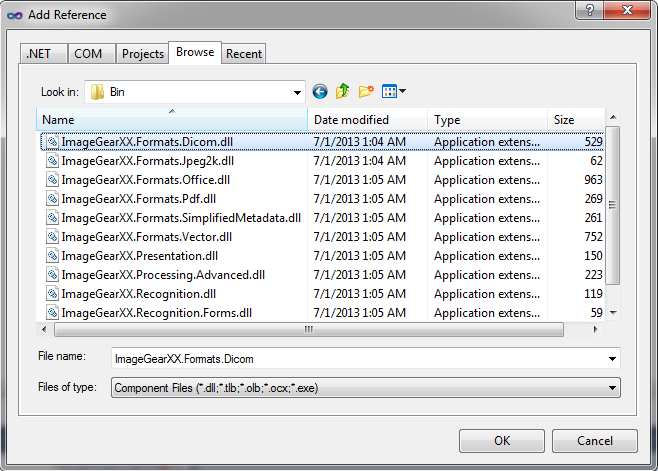Once the base of the tutorial application is completed, you can extend it with DICOM support using the following steps:
- First, you need to add a reference to the ImageGear for .NET DICOM Assembly.
- In the Solution Explorer, right-click on References, and choose Add Reference.
- Choose the Browse tab, navigate to "ImageGear for .NET v21\Bin" directory
- Select ImageGear21.Formats.Dicom.dll, and click OK.
You should now have the ImageGear21.Formats.Dicom assembly listed under References in the Solution Explorer.

-
Next, add the DICOM using statement. Open the code for Window1.xaml.cs. At the top of the code add the following statement:
C#  Copy Code
Copy Codeusing ImageGear.Formats.DICOM; - Add the following statements in Window1 constructor:
C#  Copy Code
Copy Code// Support for DICOM format ImGearFileFormats.Filters.Insert(0, ImGearDICOM.CreateDICOMFormat()); // Set DICOM DIMSE control value for wide range of DICOM file detection. ImGearFileFormats.Filters.Get(ImGearFormats.DICOM).Parameters.GetByName("LoadDetectSkipDIMSE").Value = true; // Set LoadConcatenateRepeatedDE flag to true by default. ImGearFileFormats.Filters.Get(ImGearFormats.DICOM).Parameters.GetByName("LoadConcatenateRepeatedDE").Value = true;
This will add the DICOM format to the ImageGear formats list. And now you are ready to compile and run the finished application supporting DICOM pages.
- To add support for DICOM documents, the following changes should be made:
- Add the following field to Window1:
C#  Copy Code
Copy Codeprivate ImGearDocument igDocument; - In OpenExecuted find the following code:
and replace it with:C#  Copy Code
Copy CodeigPage = ImGearFileFormats.LoadPage(stream, 0);
C#  Copy Code
Copy CodeigDocument = ImGearFileFormats.LoadDocument(stream, 0, 1); igPage = imGearDocument.Pages[0];
It does the same thing, but using the ImGearDocument API.
Now you are ready to compile and run the finished application working with DICOM documents.
- Add the following field to Window1:
- To add support for loading/saving overlays, the following changes should be made:
- First, you need to add a reference to the ImageGear ART assembly (ImageGear21.Art.dll).
- Next, add the corresponding using statement:
C#  Copy Code
Copy Codeusing ImageGear.ART; - Modify the code of the OpenExecuted in "if (null != igPage && null != igPage.DIB && !igPage.DIB.IsEmpty())" block to be:
imGearPageView1.Update() call:
C#  Copy Code
Copy Code// DICOM overlays ImGearARTPage artPage = ImGearDICOM.LoadOverlay(igPage, false); if (artPage == null) { artPage = new ImGearARTPage(); } artGUI.Page = artPage; // Create a new page display igPageDisplay = new ImGearPresentationPageDisplay(igPage, artPage); // Associate page with the page view imGearPageView1.Display = igPageDisplay; // Cause the page view to update imGearPageView1.Update();
This will enable displaying overlays after loading the DICOM page.
- To enable saving overlays, the following statement should be added right before saving the page into file:
C#  Copy Code
Copy CodeImGearDICOM.SaveOverlay((imGearPageView1.Display.ARTPage as ImGearARTPage), imGearPageView1.Display.Page as ImGearRasterPage);
- To add support for loading/saving presentation state, the following changes should be made:
- Repeat steps from points 5a - 5e.
- Declare the following member variables:
C#  Copy Code
Copy Codeprivate ImGearMetadataHead presStateOrigMetadata; public static RoutedCommand LoadPresStateCmd = new RoutedCommand(); public static RoutedCommand SavePresStateCmd = new RoutedCommand();
- Create "Load Presentation State" and "Save Presentation State" menu items under the File menu in Window1.xaml file.
XAML  Copy Code
Copy Code<MenuItem Name="mnuLoadPresState" Header="_Load Presentation State" Command="{x:Static custom:Window1.LoadPresStateCmd}"/> <MenuItem Name="mnuSavePresState" Header="_Save Presentation State" Command="{x:Static custom:Window1.SavePresStateCmd}"/>
- Add command bindings under the <Window.CommandBindings> section of the Window1.xaml file:
Right-click over each entry and click 'Navigate to Even Handler' to add the C# handler to the Window1 class in the .xaml.cs file.XAML  Copy Code
Copy Code<CommandBinding Command="{x:Static custom:Window1.LoadPresStateCmd}" CanExecute="CanExectutePageAvailable" Executed="LoadPresState"/> <CommandBinding Command="{x:Static custom:Window1.SavePresStateCmd}" CanExecute="CanExectutePageAvailable" Executed="SavePresState"/>
- Add the following code for the "Load Presentation State" menu item handler:
C#  Copy Code
Copy Codeif (!(igPage is ImGearRasterPage)) { return; } System.Windows.Forms.OpenFileDialog od = new System.Windows.Forms.OpenFileDialog(); od.Filter = "Presentation State (*.pre)|*.pre|All files (*.*)|*.*"; od.Title = "Select Presentation State File"; if (od.ShowDialog() == System.Windows.Forms.DialogResult.OK) { using (FileStream fileContent = new FileStream(od.FileName, FileMode.Open)) { ImGearPresStateOptions opts = new ImGearPresStateOptions(); presStateOrigMetadata = ImGearDICOM.LoadPresState(fileContent, (ImGearRasterPage)igPage, imGearPageView1.Display, opts); imGearPageView1.Update(); } }
- Add the following code for the "Save Presentation State" menu item handler:
C#  Copy Code
Copy CodeSystem.Windows.Forms.SaveFileDialog sd = new System.Windows.Forms.SaveFileDialog (); sd.Filter = "Presentation State (*.pre)|*.pre|All files (*.*)|*.*"; sd.Title = "Save Presentation State File"; if (sd.ShowDialog() == System.Windows.Forms.DialogResult.OK) { using (FileStream fileContent = new FileStream(sd.FileName, FileMode.Create)) { if (igPage is ImGearRasterPage) { ImGearPresStateOptions opts = new ImGearPresStateOptions(); ImGearMetadataHead presStateMetadata = ImGearDICOM.PreparePresStateMetadata((ImGearRasterPage)igPage, imGearPageView1.Display, presStateOrigMetadata, opts); // Note: The application can edit presStateMetadata here ImGearDICOM.SavePresState(fileContent, presStateMetadata); } } }
- And then add the following statement in the "Load Page" menu item handler's code, right before the imGearPageView1.Invalidate() statement:
C#  Copy Code
Copy Code// Delete presStateOrigMetadata if any presStateOrigMetadata = null;




